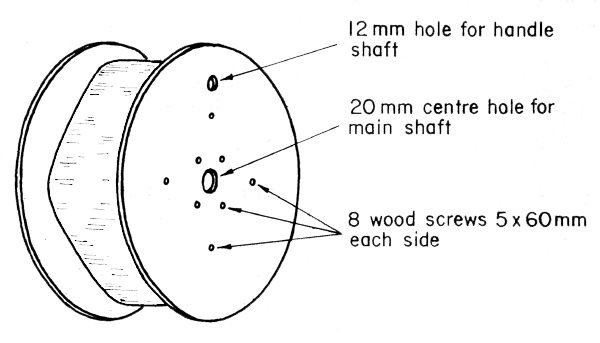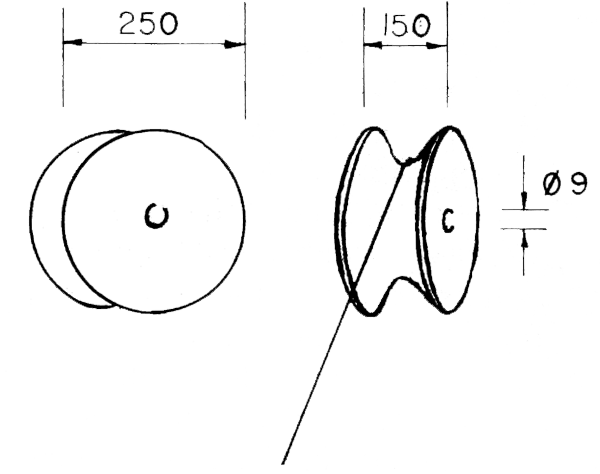There are many species of squid available in the world's oceans, and since squid jigging requires little modification to general handline gear it is well suited as a seasonal activity to supplement existing handline operations or any other traditional fishery. Since squid is also a good bait fish we believe it is proper to include squid jigging in this booklet.
Squid jigging most often takes place at night with bright overhead lights to attract the squid.
Jigs of various types, makes and colour are attached to the handline at 70 to 90 cm intervals. Often as many as 8 to 12 jigs are on one line, and many more are used on automated squid reeling systems.
The lines are lowered to 30 to 100 m depth depending on the strength of the lights used, but less deep on a small boat with one or two lamps.
It is important to keep the jig moving constantly in the water. This is usually done by jerking the line, quickly pulling in the slack, jerking once again and so on, until the jig is back to the surface (Figure 60). The line is then thrown out and allowed to sink to the desired depth, and the same jerking motion is repeated over again.
Squid eat a lot and therefore grow very fast. They eat almost anything: crab, shrimp, small fish and even other squid. They swim very fast using water jet propulsion but still are often eaten by whales, seals, birds and large fish. They have an ink sack from which they produce a black cloud around themselves in which to hide when they are scared. They also change colour as they move from shade to light and vice versa and are therfore difficult to see. This explains why they can be difficult to catch and why jigging is most often the best method.
Figure 60. Here is a fisherman on a small boat moving his hand in a constant jerk — haul in slack, jerk — haul in slack action

Squid jigs can be purchased factory-made (Figure 61), but you can also make them yourself. What you need is the following:
A round steel bolt, wood or bamboo for the stem (Figure 62a).
Suitable wire for the barbless hooks, bent into a “J” shape (Figure 62b).
Thin twine (Figure 62c).
A piece of squid or cuttlefish skin (Figure 62d).
Figure 61. Small squid jig — factory-made

Figure 62. The material you need to make a squid jig: (a) long thin bolt; (b) wire for hooks; (c) twine; (d) piece of cuttlefish or squid skin

Take the twine and tie the wire hooks around the threads of the bolt (Figure 63). Next, wrap the skin around the bolt and tie well with a loop on the end for the line.
You can also use a piece of thin bamboo (Figure 64a). Tie the wire used for barbless hooks with thin wire, and form loops at both ends of the jig (Figure 64b). Finally, wrap the skin or coloured plastic around the stem (Figure 64c).
If you use bamboo, make sure enough weight is put on the jig to sink it. This you can do either by adding weight to the end of your line or by wrapping a thin lead sheet around the bamboo stem before the coloured plastic or skin.
Figure 63. Bolt with wire hooks tied on

Figure 64. Using bamboo for the stem

You can use either of the reels described earlier for handlining, but if you want to make one especially for squid fishing then it is better to make the hub of the reel elliptical or oval shaped to permit the jerking movements of the jig when turning the reel. The hub should also be a little bit wider for storing the jigs.
Figure 65. Hub for the squid reel

In contrast to the hub presented in Figure 50, the hub of the squid reel should be 140 mm thick instead of 70 mm (Figure 65). It should be of oval shape but still 300 mm wide as before. The prepared squid reel is shown in Figure 66. The reel shaft will now be 230 mm long instead of 160 mm.
The handle shaft will be 324 mm long instead of 254 mm, but that is all we need to change on the reel itself.
Figure 66. Squid reel ready for assembly

To make squid jigging easier and more effective, a guide roller can be fixed on the bulwark with a steel frame covered with wire mesh netting to receive the squid as they fall off the barbless hooks and guide them into the boat.
The material to be used for the frame is 40 mm thick angle-iron approximately 3.5 to 4 mm broad. Start with a total length of 1 850 mm or 185 cm. Cut into three pieces as shown in Figure 67: two of 750 cm (A) and one of 350 cm (B).
From each of the two larger pieces (A), cut off a length of 30 cm (C); these you will use for the roller's support after drilling a 9 mm hole in each.
Now heat and bend the remaining flat piece according to the thickness of the planking or capping of your boat. After bending, drill holes on the top and side for fastening the frame to the boat (Figure 67). The size and number of holes for fastening the frame will depend on the type of boat you are planning to use it on.
Now cut out a piece of wire mesh netting and weld the whole thing together as shown in Figure 68.
The guide roller should be made of hardwood, but you can use a roller made from plastic or iron if a suitable one can be found. The roller should be 250 mm in diameter and 150 mm thick and it should have a groove as shown in Figure 69.
Figure 70 shows how the roller is fastened to the frame. Through the 9 mm diameter central hole you will pass a bolt 180 mm long and 8 mm in diameter of bronze or galvanized steel with threads for a nut on one end. Use fibreglass or plastic washers on both sides of the roller and do not tighten the nut too much. Again a locknut should be used if necessary.
Figure 67. Measuring and cutting angle-iron into segments for the frame

Figure 68. Assembling the wire mesh frame

Figure 69. Size and shape of the roller

Figure 70. Fastening the roller on the wire mesh frame

Figure 71. The height of the roller

The height of the roller above the wire mesh frame depends on whether or not you are using the snood method for your jigs. If you use the direct head-to-end method (Figure 71a) then the height is not so important, but if you are using snoods (Figure 71b) then the roller must be high to avoid tangling of the jigs with the wire mesh netting.
Now put the reel in its position and you are ready to squid jig with the handreel, roller and wire mesh frame (Figure 72).
Figure 72. Squid fishing with handreel

In strong winds handlining and especially squid jigging often become inefficient because of the fast drifting and heavy rolling of the boat. This problem can be minimized by making a simple sea anchor (drift anchor).
You will need the following materials (Figure 73):
A canvas triangle measuring 3 m on each side.
A sail maker's spike.
A needle and strong twine.
A 10 mm round iron bar.
7 or 8 m of 10 mm nylon rope.

Figure 73. Materials needed to construct a sea anchor

Figure 74. Constructing the sea anchor
First fold the edge of one part of the canvas cloth and then sew a tube large enough for the 10 mm round bar (Figure 74a). Then put the bar through and bend both ends to form a loop (Figure 74b). Next sew the ropes to both remaining sides (Figure 74c), leaving ends on both sides long enough to knit them to the bar loops and making a spliced eye or loop at the top (Figure 74d). Your drift anchor is ready except for the bridles and the float.
To rig the sea anchor (Figure 75) you will need the following additional materials:
A large float.
12 mm nylon rope for bridles.
Swivels.
16 mm rope to use for the anchor rope, safety rope and float rope.
Sinkers.
The bridles should be 7 to 8 m long, spliced to a large swivel on to which you fasten your anchor rope. You should also use a swivel for your float rope.
When the sea anchor is not in use you must wind the canvas up on the round bar at the bottom. Remember to always keep it on board, as it can also be used as a sail.

Figure 75. Rigging and using the sea anchor
Sometimes squid can be caught by jigging during the daytime, especially in areas where they come in large schools for spawning, but more often they are caught at night with the help of lights.
Another booklet in the FAO Training Series is entitled Attracting fish with light. You should read this booklet, as it tells a lot about light attraction fishing, how it works, how to prepare your own lights, etc.
Figure 76. Lights on a small canoe

On a small canoe, for example (Figure 76), you can fix one or two lamps above or even outside the bulwark on one side (see Figure 68) and still create a shaded zone under the boat. On larger boats with stronger lights the lamps should always be positioned well above and inside the boat (see Figure 77).
Sometimes underwater lights are used on large boats. They are sunk as deep as possible and then slowly hauled back to the boat (Figure 78). This is done to try to lure the squid from deep water into the light or shade from the above deck lights.
Figure 77. A larger boat with the lights well above the deck

Figure 78. Underwater lamp hauled from deep water to lure the squid to the surface
